Disclaimer: The Private Snafu cartoons, intended for viewing by the US Army, are products of American propaganda during World War II. Like many of the finished Snafu films, the story outline and script seen here exploit racial and gender stereotypes that are harmful today. The documents shown are presented unedited in the interests of cultural and animation history of the WWII era.
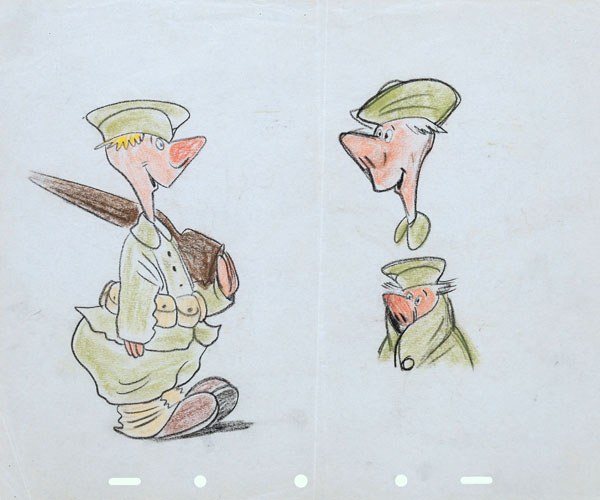
Snafu – earlier design from Disney
In late 1942, Frank Capra conceived Private Snafu as the antithesis of the average American soldier—one who would make every mistake and defy military regulations and safety. His animated films were intended to emphasize the importance of following Army protocol, provide general advice for soldiers, and to explain various military topics. Rather than portray Snafu’s ineptitude in the usual didactic way of instructional films that servicemen endured, Capra chose a more entertaining approach to get the point across.
Capra first approached Walt Disney to make the Snafu cartoons, based on that studio’s work in Capra’s Why We Fight series. The Disney artists created preliminary character designs; the first Snafu episode (Coming Snafu), which would introduce the bungling GI to military audiences, had a finished storyboard. Leon Schlesinger made a rival offer to produce the Snafu films for less than Disney and won the contract. Chuck Jones and his character layout artist Art Heinemann redesigned Private Snafu for all the Schlesinger directors: himself, Friz Freleng, Bob Clampett, and Frank Tashlin.
At the start of 1943, Snafu debuted in Army-Navy Screen Magazine (then called simply The War in its early installments), a collection of live-action news and information reels, similar to civilian newsreels like Fox Movietone News or Paramount News. Between 1943 and 1945, Snafu appeared in films produced by Schlesinger and, after mid-1944, Warner Bros. Cartoons, Inc., the successor to the Schlesinger studio. Meanwhile, MGM and the burgeoning United Film Productions (later UPA) handled a companion series, A Few Quick Facts, which took a more didactic, educational approach.
The last few Snafu cartoons reflected the American invasion of the Pacific islands close to the Japanese homeland after the German Third Reich surrendered in May 1945. After their victory in the Battle of Iwo Jima earlier in March, the American forces advanced to the island of Okinawa in April 1945. By early June, Okinawa was declared secure after a vicious battle, although American troops were ordered to “mop up” the remainder of the island. Many Japanese soldiers hid in caves to resist their surrender to the American forces and conduct guerilla warfare; the Army blasted the Japanese soldiers (and some civilians) out with grenades and flamethrowers.
MGM was contracted to produce a Snafu in that same vein, Mop-Up, which seems to have been heavily influenced by the events in Okinawa. However, the US Army canceled the film. Mike Lah, an animator on the film, said in an interview with Milton Gray three decades later: “Owen Fitzgerald was our layout man, and he had this great big Japanese wrestler. We had a lot of great, funny stuff in pencil test form, and it was 60 or 70 percent inked and painted. They dropped the Hiroshima bomb [on August 6], and the next day, we got instructions to stop production. Two days after that, they came in and lifted everything we had—cels, pencil test, drawings, anything we had—put it on a truck, and away they went.”

While some sources have stated that Tex Avery was slated to direct Mop-Up, a surviving synopsis in the MGM scripts collection, held at the Margaret Herrick Library, reveals that the Hanna-Barbera unit was to handle the project. Besides 1943’s War Dogs and The Yankee Doodle Mouse (the team’s first Oscar winner), Hanna and Barbera generally shied away from topical references in their cartoons, in sharp contrast to Avery, which are rife with contemporary references. Here is the scene-by-scene synopsis—for those unaware, “PX” is a shortened abbreviation for Post Exchange, a type of store where American soldiers, sailors, and airmen could buy sundries and food items):
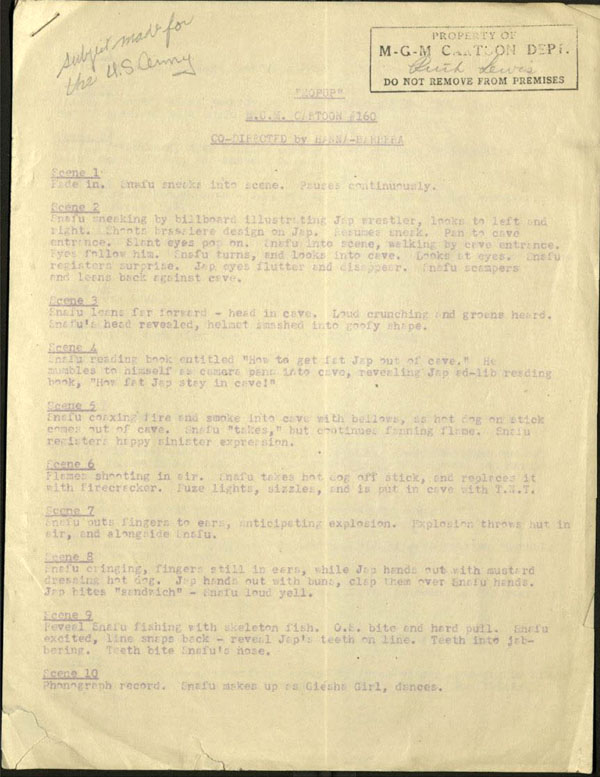
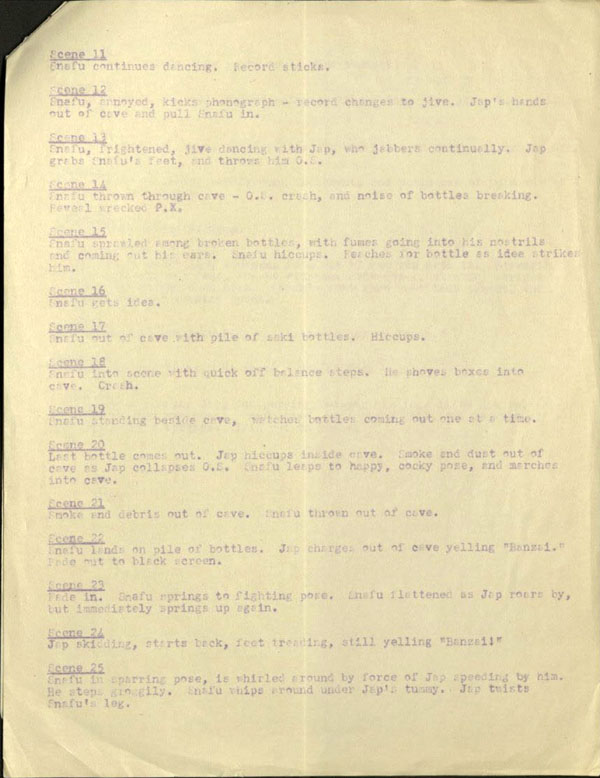

Here is a copy of a more detailed scenario script of Mop-Up from Mark Kausler’s collection (click to enlarge each page). The document is dated June 21, 1945 — the date of the Japanese defeat in Okinawa. Mark adds: “Mike Lah did a lot of the animation on this one, and he told me that he was quite downcast when they canceled the project since he was proud of the animation he had done with Snafu and the Fat Jap’ doing hand-to-hand combat.”
A minor difference between the synopsis and the detailed scenario is Snafu’s defeat of the sumo wrestler. The synopsis has Snafu toss a bomb at the wrestler, whereas, in the revised scenario, Snafu’s wind-up takes on the shape of a rocket, indicative that Hanna and Barbera wanted to expand his final blow to the enemy, a la Popeye the Sailor, much farther. Bill and Joe also borrowed from a sequence in Friz Freleng’s Bugs Bunny Nips the Nips, released in 1944, with Bugs up against a fat sumo wrestler—as well, Snafu dresses in drag much like Bugs in the 1944 Freleng cartoon, as he would again in Operation Snafu.
While Mike Lah’s recollection of Mop-Up’s cancellation syncs with the atomic bombings of Hiroshima and Nagasaki, one speculative theory posits that the US Army might have canceled the film on the grounds of taste since reports of the mass suicides in Okinawan caves had reached the American press.
Though Japan surrendered to the Allies on board the battleship USS Missouri in early September 1945, many troops still awaited release from their military duties and back to civilian life as of October. That same month, Army-Navy Screen Magazine included the last two Snafus farmed out to Warners, Operation Snafu and No Buddy Atoll, both set in the Pacific. The two films were pure entertainment without a message—Snafu now became a more competent soldier in deadly and precarious situations. The Allied victory in World War II brought the series’ abrupt end after Hugh Harman Productions finished Seaman Tarfu in the Navy, the first in a proposed series centered on Snafu’s sailor brother, by January 1946.
On the subject of absent Snafu shorts, the Margaret Herrick Library does not hold any materials for Secrets of the Caribbean, an unreleased Snafu directed by Chuck Jones. Michael S. Shull and David E. Wilt’s book Doing Their Bit: Wartime American Animated Short Films, 1939-45 summarizes: “Private Snafu is stationed in the Caribbean, guarding the Panama Canal. In his pursuit of a beautiful native girl, he is roughed up by gigantic insects, attacked by howler monkeys, and nearly eaten by a carnivorous plant.” (It is not clear where the information for the synopsis originates.) No storyboard drawings or photostats of a storyboard have surfaced regarding Mop-Up or Secrets, but hopefully, that will change sometime soon.
Special thanks and acknowledgments to The Margaret Herrick Library (AMPAS), Mark Kausler, Eric Costello, Michael Barrier, Steve Stanchfield, Jorge Finkielman and Frank Young for the production materials and assistance with this post.


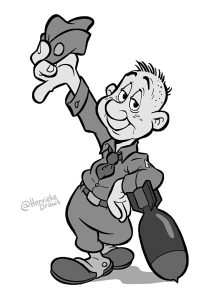

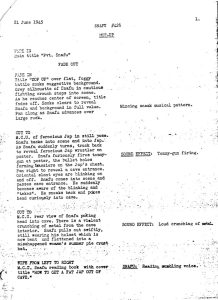

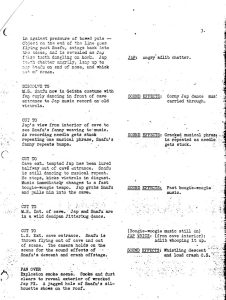


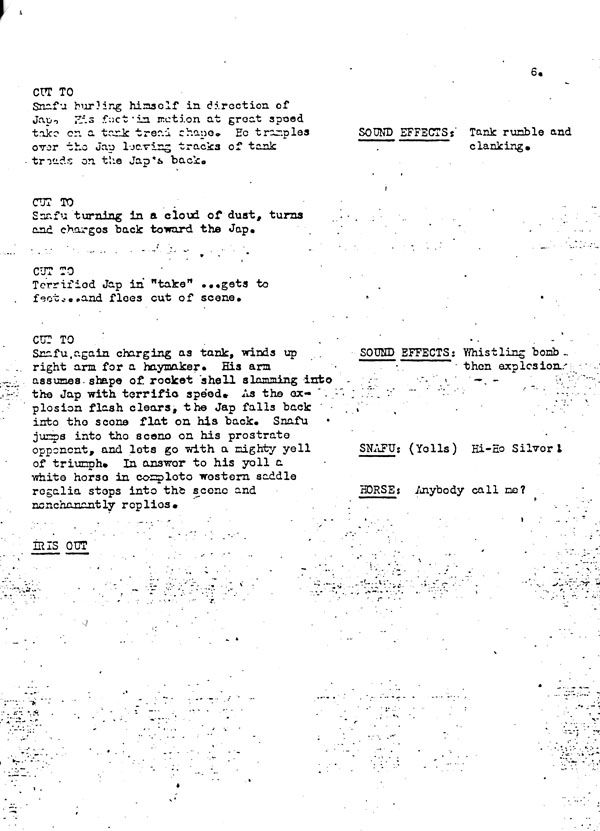
 DEVON BAXTER is a film restoration artist, video editor, and animation researcher/writer currently residing in Pennsylvania. He also hosts a
DEVON BAXTER is a film restoration artist, video editor, and animation researcher/writer currently residing in Pennsylvania. He also hosts a 




















































































You wouldn’t think Tarfu was necessary since there was already Hook. There should have been a cartoon with Snafu, Tarfu, and Hook dealing with demobilization at the end of the war.
I think that was a case where you had two different backers, the Army and the Navy, working in parallel. And it’s not at all improbable that neither knew what the other was doing.
Was life lessons a thing in the ’40s? I remember in the ’80s and ’90s Hank Ketcham’s comics character Half Hitch illustrated a few posters for financial planning for the Navy.
Well, for example, think about “Pay Day,” one of the Snafu entries directed by Friz Freleng, which comically (and brilliantly, in my view) showed the effects of not saving one’s pay, and frittering it away on booze, broads, gambling and souvenirs. The Hook cartoons (in which Ketcham had a role) also promoted the sale of war bonds. So I’d say yes, life lessons were a thing during the war.
What a shame there are two missing SNAFU cartoons. Would that the animation cels for Mop-Up existed somewhere that someone could compile them into a near finished cartoon.
But at first I thought you were going to show us the drawn storyboard for Disney’s version! Does Disney still have it?
Disney’s storyboard is in David Gerstein’s Mickey and the Gang: Classic Stories in Verse, pages 330-331.
Having Snafu acquire super strength by eating a name-brand product like Spam probably wouldn’t fly in a cartoon intended for general theatrical release. But I’m sure the soldiers watching “Mop-Up”, had it been completed, would have had a huge laugh at that scene.
Very interesting finding, but this begs the question, did Hanna/Barbera direct the Snafu segments from the “a Few Quick Facts” as well? I know that MGM (along with Disney and UPA) handled that series, but never knew which people work on the MGM-produced segments. I can recognize some of Michael Lah’s animation there though.
A disclaimer on history is ludicrous. Just tell it like it is/was, and let people deal with it as they will.